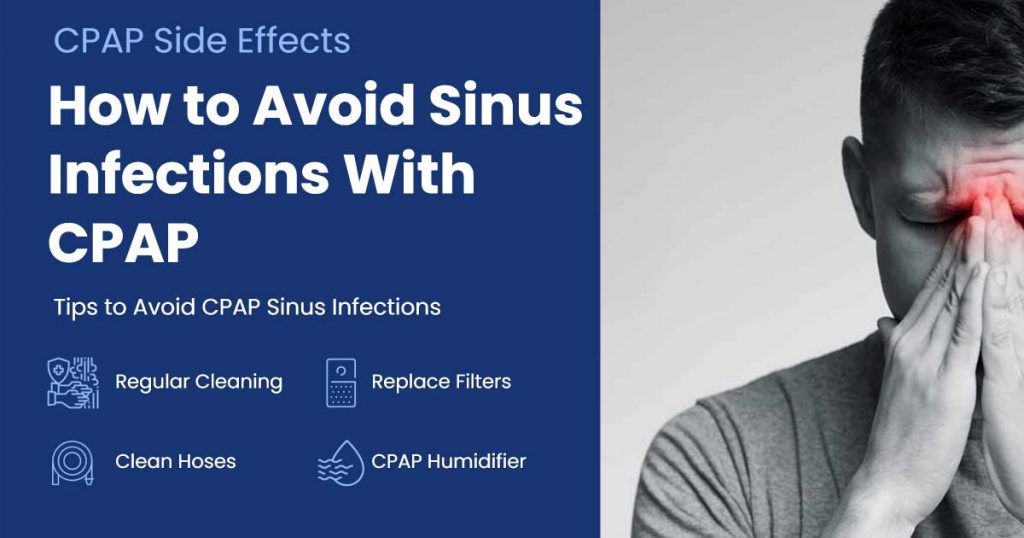
CPAP therapy is the gold standard for treating Obstructive Sleep Apnea (OSA). While CPAP is a lifesaver for those living with OSA, common CPAP side effects like dry eyes, facial irritation, and headaches tend to deter people from consistently sticking with their CPAP therapy. For those with seasonal or chronic allergies, sinus infections are a common cause for concern when it comes to CPAP machines.
Fortunately, we’ve found that so long as you stick with a regular cleaning schedule, CPAP therapy won’t directly result in a higher risk for sinus infections. Regularly replacing or cleaning your air filter (depending on whether your machine uses reusable or disposable filters), regularly rinsing and disinfecting your CPAP hose, and regularly emptying and cleaning your humidifier chamber will have the greatest contribution toward protecting you against getting a sinus infection from CPAP.
There’s more to discuss and some details to consider, so keep reading, and we’ll break down everything you need to know about CPAP sinus infections and how to prevent them.
Can CPAP Cause Sinus Infections?
CPAP therapy, without humidification, inherently dries the airway and delivers filtered air from your environment into your respiratory system. While there is potential for bacteria buildup when a CPAP machine is not properly maintained, CPAP therapy in and of itself is not correlated with an increased risk for sinus infections.
Research from 2012 shows that nasal inflammation and sinus infections are common occurrences in OSA patients; an additional 2016 study further adds to this claim, stating that those with OSA were 3.18 times as likely as those without OSA to develop chronic rhinosinusitis.
More significantly, however, it also showed that those who regularly used their CPAP machines actually had more tolerance to bacterial infiltration of their disease-fighting white blood cells. This same tolerance was not found in those who were not undergoing CPAP therapy, allowing us to conclude that regular CPAP therapy actually has a more protective effect rather than a detrimental one when it comes to sinus infections.
A 2017 study further revealed that those undergoing CPAP therapy did not experience a higher frequency of sinus infections than those who were not on CPAP therapy. It also found that your choice of mask, machine, and humidifier does not significantly impact the occurrence of sinus infections, either.
While a CPAP machine does not cause sinus or nasal infections directly, poor maintenance and incorrect use of the device can lead to airway irritation and sinus infections. Thus, the risk of sinus infection from CPAP is only likely if you overlook the significance of cleaning the machine regularly.
Microbial infestation can occur in the device’s tubing or the mask when equipment is not regularly cleaned. The humidifier can also harbor mold and fungus, increasing your risk of a CPAP sinus infection.
Steps to Avoid Sinus Infections From CPAP
Regular maintenance of your CPAP machine is the most viable solution to avoid CPAP sinus issues. Below is a list of steps you can take to make yourself less susceptible to sinus infections from a CPAP machine:
1. Clean Your CPAP Thoroughly and Replace Air Filters
Maintaining clean CPAP equipment is something everyone should prioritize and is especially important if you’re someone who frequently experiences seasonal or chronic allergy symptoms. Every single day after waking up, you should clean your CPAP mask and its cushion or nasal pillows with warm water and a mild soap. You should also empty and dry your humidifier chamber and hang your hose to dry as well. You’ll also want to clean your humidifier chamber and hose once weekly with soap and water.
You’ll also want to be sure to replace your machine’s disposable air filter once a month if it uses one. If your machine has a reusable filter, it should be rinsed every week and replaced every six months.
Specialized CPAP cleaners are also available for effectively reducing infection risk by fungi, mold, and bacteria with further sanitization, though these products should be used in addition to your regular cleaning routine and not as a substitute for it. We also carry the antimicrobial Healthy Hose Pro, which prevents and eliminates up to 99.99% of bacteria.
2. Use Distilled Water
Heated humidification is crucial to prevent the development of adverse symptoms such as dry mouth, nasal congestion, nose bleeds, and stuffy nose. However, some microorganisms like yeast and mold thrive better in hot and humid environments, and it’s even possible that your local water supply is contaminated with microbes as well.
To stay safe from fungal infections, use distilled water in the humidifier. Not only does distilled CPAP water protect your machine from mineral buildup caused by tap water, but it also reduces the risk of amoebal infections.
3. Find the Right Humidifier Setting and Consider a Heated Hose
Heated humidification with CPAP wasn’t actually found to reduce the prevalence of sinus infections per the 2017 study we referenced earlier, though it does help alleviate symptoms associated with dryness in the airway. With humidifier usage, however, there’s always the chance of too much condensation buildup in the hose. This water accumulation can promote microbial growth when using a humidifier for a prolonged time, especially if you aren’t letting your hose drip dry every morning after use.
Since, on the other hand, a lack of humidity can also pose problems such as mucosal dryness, you don’t necessarily want to totally cut humidification out either. Heated hoses allow you to maintain a consistent temperature throughout the hose as your humidified therapy air travels to you. This reduces condensation buildup and provides a more consistent CPAP experience throughout seasonal changes, too.
4. Don’t Share CPAP With Others, Including Your Sick Self
This probably goes without saying, but you shouldn’t use a mask, cushion, or tube that was used by somebody else, even your spouse or family member. You also need to take special care to disinfect your equipment during and after any contagious illnesses you experience. When down with a cold or flu, you should frequently clean your mask and tubing of any accumulated mucus so that it doesn’t return to make you sick again after you recover.
Frequently Asked Questions About CPAP Sinus Infections
Can a CPAP Machine Cause a Sinus Infection?
No, a CPAP machine cannot cause a sinus infection when properly cleaned and maintained, but there is a risk of infection for those without regular cleaning routines. Using distilled water, regularly replacing your air filter, and rinsing and drying your humidifier chamber and hose each day after use will drastically reduce your chances of developing a sinus infection from CPAP.
Should I Stop Using My CPAP When I Have a Sinus Infection?
As a rule of thumb, you want to continue with your CPAP therapy even when you’re sick. The drawbacks of untreated sleep apnea will not benefit your recovery, and utilizing your humidifier and ramp feature may help you tolerate the pressure more easily when sick. A full face mask may also be good to have on hand for these times if you regularly wear a nasal mask since it can take the edge off of nasal inflammation during your therapy.
What Kind of Infections Can You Get from a CPAP Machine?
While CPAP machines do not cause infections in and of themselves, using dirty equipment can enhance the risk of developing an illness. Water and mucus buildup in the mask and tube promotes microbial growth that could lead to sinus infections, pneumonia, bronchitis, respiratory infections, and allergic reactions like coughing and sneezing.
How Do You Know if Your CPAP Is Making You Sick?
The first indicator that your CPAP machine is making you sick is repeated sickness over the course of a few months. If you typically have the same types of respiratory infections or cold and flu symptoms, it may be worth evaluating your CPAP machine’s cleanliness. A faint smell of mold or mildew may also be an indicator of an unclean CPAP machine that’s putting you at risk of illness.
How Do I Get Rid of Nasal Congestion From CPAP?
Heated, humidified air can reduce nasal congestion caused by the continuous dry air pressure of CPAP therapy. Nasal saline sprays can help reduce nasal congestion caused by this inflammation, but a heated humidifier is your best bet for finding relief.
What Happens if Your CPAP Humidity Is Too High?
Very high humidity causes rainout, which is defined as a buildup of moisture in the mask and tubing that splashes onto your face, waking you up. Too much humidity can also lead to water accumulation that promotes microbial growth and increases your chance of developing sinus and respiratory infections.
What Humidity Should My CPAP Be Set At?
You should ultimately set the humidity level according to your needs. Most machines have varying levels of humidification, so start one setting below half of the maximum setting and see how that works for you. If you’re still experiencing dryness, turn it up. If you’re experiencing rainout or running out of water before the night is through, turn it down.
Final Thoughts
Simply put, there is no direct link between CPAP machines and sinus infections. CPAP machines are sterile when you receive them and safe to use out of the box. But with continuous use, it is inevitable for bacteria, mold, and other microorganisms to accumulate that might make their way into your airway.
When it comes to CPAP machines and sinus infections, unclean and dirty equipment increases the risk of infection. By regularly cleaning your equipment and replacing air filters as necessary, you can significantly reduce your risk of developing a sinus infection from CPAP. If you do get sick, make sure to thoroughly clean and sanitize your equipment after each use and do your best to stick with therapy in the meantime.




